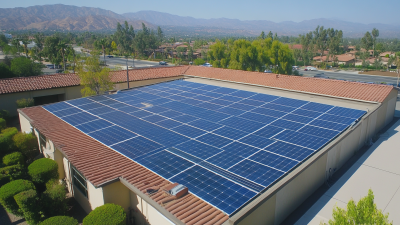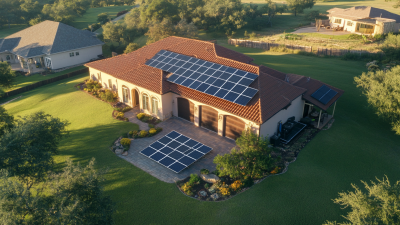The Future of Energy How Solar Panels are Transforming Our World
The increasing adoption of Solar Panels represents a pivotal shift in the global energy landscape, driven by escalating energy demands and the urgent need for sustainable solutions. According to a report by the International Energy Agency (IEA), solar energy could become the largest source of electricity generation by 2030, accounting for over 30% of global energy production. In parallel, the Bloomberg New Energy Finance report projects that the cost of solar energy will continue to decline, making it cheaper than fossil fuels in many regions by 2025. This transition not only promises to reduce greenhouse gas emissions significantly but also enhances energy security and creates numerous job opportunities within the renewable energy sector. As technology advances and government policies become increasingly supportive, Solar Panels are not just transforming how we generate electricity, but are also shaping a more sustainable future for our planet.

The Rise of Solar Energy: A Global Perspective on Adoption Rates
The adoption of solar energy is experiencing a significant surge globally, driven by both technological advancements and increasing awareness of environmental issues. According to the International Energy Agency (IEA), solar power capacity reached over 940 gigawatts (GW) globally by the end of 2021, marking a 24% increase from the previous year. This trend is expected to accelerate, with projections suggesting that solar energy could account for nearly 20% of the world’s electricity generation by 2040.

Regions such as Europe and Asia are leading the charge, with countries like Germany and China at the forefront. China alone accounted for nearly 50% of global solar capacity additions in 2021, contributing to its ambitious goal of achieving carbon neutrality by 2060. In the United States, the Solar Energy Industries Association (SEIA) reported a 34% year-over-year growth in solar installations, underscoring the ongoing shift towards renewable energy sources. This global perspective on solar energy adoption reflects a broader commitment to sustainable energy solutions, fostering economic growth while addressing climate change.
Innovative Technologies Revolutionizing Solar Panel Efficiency
Innovative technologies are at the forefront of revolutionizing solar panel efficiency, significantly enhancing their performance and accessibility. One of the most notable advancements is the development of bifacial solar panels, which can capture sunlight on both sides, increasing energy generation by up to 30% compared to traditional panels. This technology maximizes energy production even in less-than-ideal conditions, making solar power more viable in various environments.
Additionally, improvements in perovskite solar cell technology promise to further bolster efficiency rates. These cells, which can be manufactured at a lower cost and with greater flexibility than conventional silicon cells, have demonstrated remarkable potential in lab settings. Their ability to be combined with existing solar technologies can lead to a new generation of hybrid systems, showcasing a significant leap toward more sustainable and economical solar energy solutions.
This convergence of technology not only enhances the output of solar energy but also paves the way for greater adoption, ultimately transforming our approach to renewable energy.
Economic Impacts: How Solar Power is Shaping Job Markets and Industries
The shift towards solar energy is reshaping our job markets and industries in remarkable ways. As reported by the Solar Foundation's National Solar Jobs Census, the U.S. solar industry employed over 250,000 workers in 2019, marking a 167% increase since 2010. This growth trajectory highlights the demand for skilled labor in installation, maintenance, and manufacturing sectors, indicating that solar energy is not just environmentally beneficial but also economically advantageous.
Tips for individuals looking to enter this booming industry include seeking certifications in solar technology and attending workshops to enhance practical skills. Networking through renewable energy forums can also provide valuable insights into emerging trends and job openings.
In addition to creating jobs, solar power is also stimulating new industries. A 2021 report by the International Renewable Energy Agency (IRENA) revealed that the solar sector is a catalyst for innovation, prompting advancements in energy storage solutions and smart grid technologies. As companies adapt to renewable energy practices, professionals in engineering, installation, and regulatory policy are finding abundant opportunities in this expanding field. Fostering a culture of continuous learning will be essential for those who want to stay competitive in the evolving energy landscape.
Environmental Benefits: Solar Energy's Role in Combatting Climate Change
The environmental benefits of solar energy are increasingly recognized as a vital component in combatting climate change. According to the International Renewable Energy Agency (IRENA), solar power has the potential to reduce global CO2 emissions by up to 4.4 gigatons annually by 2030. This substantial reduction is crucial, given that the energy sector is one of the largest contributors to greenhouse gas emissions worldwide. The shift towards solar energy can significantly mitigate these effects, providing a clear path towards a sustainable future.
Moreover, a report from the National Renewable Energy Laboratory (NREL) highlights that increasing solar energy adoption could lead to a decrease in health-related issues caused by air pollution, which currently costs the U.S. economy over $150 billion each year. By reducing reliance on fossil fuels, solar panels not only contribute to cleaner air but also foster energy independence. This dual advantage emphasizes solar energy’s critical role in enhancing public health while addressing climate change, making it a key player in the transition to a greener economy.

The Future Landscape: Predictions for Solar Energy Integration in Urban Areas
As urban areas continue to grow, integrating solar energy systems into city landscapes presents both opportunities and challenges. According to a report by the International Energy Agency (IEA), solar energy could provide up to 30% of global electricity demand by 2030, significantly enhancing urban sustainability. As municipalities adopt policies favoring renewable sources, the deployment of solar panels on rooftops and community spaces becomes increasingly prevalent, fostering energy resilience and reducing carbon footprints.
Tip: When considering solar energy integration for your urban home or business, look into local government incentives that can offset installation costs. Many cities offer tax credits or rebates, making solar panels a more affordable investment.
As cities evolve to accommodate a larger population, innovative designs for solar integration are emerging. Solutions such as building-integrated photovoltaics (BIPV) are gaining traction, allowing solar technology to blend with architectural features without compromising aesthetics. A study from the National Renewable Energy Laboratory (NREL) indicates that implementing BIPV could lead to a 60% increase in solar energy generation in urban centers by 2040.
Tip: Explore the feasibility of solar panel installations in your community by joining local groups focused on renewable energy; collaborative projects can often lead to reduced installation costs and shared knowledge.
The Future of Energy: How Solar Panels are Transforming Our World
| City | Solar Capacity (MW) | Solar Coverage (% of rooftops) | CO2 Reduction (ton/year) | Jobs Created |
|---|---|---|---|---|
| City A | 150 | 25 | 1200 | 30 |
| City B | 200 | 35 | 1800 | 50 |
| City C | 95 | 20 | 800 | 15 |
| City D | 125 | 30 | 1000 | 28 |
| City E | 175 | 40 | 1500 | 45 |
Related Posts
-

Unlocking the Benefits of Solar Power Solutions for Your Business
-

Comprehensive Resource on Solar Panel Systems for Global Buyers
-

How to Choose the Best Residential Solar Power Systems for Your Home
-

Challenges Faced by Global Buyers in Sourcing Solar Energy Systems
-

Finding Reliable Suppliers for Off Grid Solar Power Solutions A Comprehensive Guide
-

Innovative Solar Solutions to Power Your Business for a Sustainable Future

